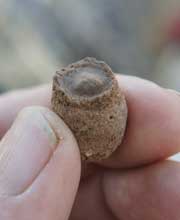What Do Females of Centris pallida Do to Reproduce?

Digging females of Centris pallida tunnel down through sandy to gravelly soil for about a foot or so before finishing off the burrow with an inch-long vertical, terminal cell located roughly eight inches beneath the surface of the soil. In this cell, the female forms a brood pot lined with wax that she then fills with nectar and pollen. On top of the sticky mass of food, she lays an egg, which hatches into a tiny grub that feasts on the provisions provided by its mother.

Once the food is gone and the grub’s development is complete, the baby bee turns itself into a pale grub-like prepupa, which rests quietly underground for 11 months or so. Long after its mother prepared the cell for its offspring, the prepupa eventually metamorphoses into a pupa, which in turn soon becomes an adult bee. The fresh adult digs its way up to the surface and begins a very active life beginning in April or early May that runs its course in about a month or so.

Read more about: Desert Diggers
Bibliographic details:
- Article: Female Digger Bees
- Author(s): Dr. Biology
- Publisher: Arizona State University School of Life Sciences Ask A Biologist
- Site name: ASU - Ask A Biologist
- Date published:
- Date accessed:
- Link: https://askabiologist.asu.edu/female-digger-bees
APA Style
Dr. Biology. (). Female Digger Bees. ASU - Ask A Biologist. Retrieved from https://askabiologist.asu.edu/female-digger-bees
Chicago Manual of Style
Dr. Biology. "Female Digger Bees". ASU - Ask A Biologist. . https://askabiologist.asu.edu/female-digger-bees
Dr. Biology. "Female Digger Bees". ASU - Ask A Biologist. . ASU - Ask A Biologist, Web. https://askabiologist.asu.edu/female-digger-bees
MLA 2017 Style

Be Part of
Ask A Biologist
By volunteering, or simply sending us feedback on the site. Scientists, teachers, writers, illustrators, and translators are all important to the program. If you are interested in helping with the website we have a Volunteers page to get the process started.

